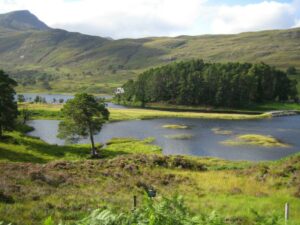
The Scottish wildcat is elusive and difficult to find. If you squint into the wilderness, you might catch a glimpse of it, as it crouches in a bed of grass, stalking its prey, which might be a rabbit or vole munching on blades of grass. It will lie in wait until the perfect moment, and then pounce to catch its dinner. Despite its unassuming small size, this cat is an important predator in its ecosystem. The presence of these cats keeps the rabbit and rodent population in check, preventing them from overgrazing on the vegetation.5 This protects the plants and maintains the harmony of the ecosystem. However, recent decades have decimated this species in the wild, putting this relationship in jeopardy. Current estimates of population range between 30-430 individuals, which is incredibly low. A variety of causes are to blame, with the three most important ones being habitat loss, human persecution, and hybridization.6
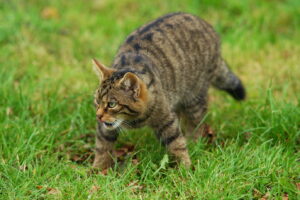
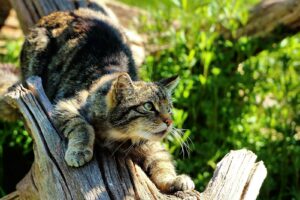
Other major threats to the Scottish wildcat population are habitat loss and human persecution.12 The natural woodlawn habitat of these wildcats has become fragmented. Pieces of their home have split up due to human interference. As people construct roads, they lose corridors connecting their habitats. Areas of intense agriculture and urbanization scare these cats away from their home, leading them to endure harsh conditions that they are not prepared for. Human persecution has been constant since the 1800’s. People viewed these wildcats as pests. Their predation on smaller mammals, like birds and rabbits, made them competitors to hunters. This encouraged men to shoot these cats in order to destroy their competition. The Scottish wildcat was also hunted and persecuted for its beautiful fur. Today, the wildcat is legally protected by law. However, it is still a victim to human persecution. Its similar physical appearance to domestic feral cats makes people confuse them for each other. This can cause hunters to mistakenly shoot this protected species. Research is currently on-going in establishing important distinctions between the two species so that they are not mistaken for each other.13
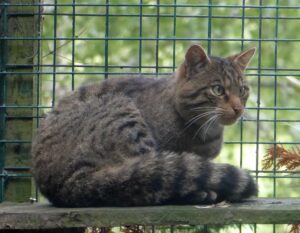
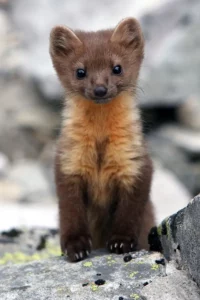
However, despite its importance to Scotland’s ecosystem, the pine marten has had significant decreases of its population and territory in the past centuries. Its population first began suffering in the 18th and 19th centuries and the years since have decimated its population across the United Kingdom. Now, it’s mostly found in Scotland and a few remote areas in northern England. The population has recovered somewhat in recent decades, but the population numbers are still low, numbering about 3,700 pine martens. 19The pine marten shares similar conservation threats to the Scottish wildcat, which are habitat loss and human persecution. These animals prefer to live in woodland areas. They are constantly climbing trees and traversing through the underbush. This makes it particularly difficult for them when their natural habitat is destroyed. As deforestation takes place, pine martens are forced to move elsewhere, into smaller, and smaller pieces of land. They require trees and grass to avoid predation, which makes it difficult to survive in open spaces20. The destruction of forests has made the lives of these creatures much harder.
Conservation efforts to protect the pine marten have been in the works for several decades and have had some success, though more work is of course needed. The Wildlife and Countryside Act of 1981 granted these animals legal protection. Hunting them became illegal, and work related to pine martens requires the use of a license. Efforts to reduce their loss of habitat are also in existence. Scotland’s Forestry and Land agency has made recent pledges too support the planting of trees needed for the survival of the pine marten. Additionally, to increase population numbers, the agency is trying to create artificial dens for pine martens to facilitate breeding.21
- August 2005 HM. 2006. Östliches Ende des Loch Affric. Hinter den Bäumen sieht man einen Teil der Affric Lodge. Im Hintergrund der Gipfel des Sgurr na Lapaich (1036 m). Bilck Richtung Nordweste. https://commons.wikimedia.org/wiki/File:Loch_Affric_bei_Lodge.jpeg. ↵
- Affric Highlands. Rewilding Europe. accessed 2024 Mar 19. https://rewildingeurope.com/landscapes/affric-highlands/. ↵
- Affric Highlands. Rewilding Europe. accessed 2024 Mar 19. https://rewildingeurope.com/landscapes/affric-highlands/. ↵
- Affric Highlands. Rewilding Europe. https://rewildingeurope.com/landscapes/affric-highlands/. ↵
- Trust W. Scottish Wildcat (Felis silvestris). Woodland Trust. https://www.woodlandtrust.org.uk/trees-woods-and-wildlife/animals/mammals/scottish-wildcat/. ↵
- Breitenmoser U, Lanz T, Breitenmoser-Würsten C. Conservation of the wildcat (Felis silvestris) in Scotland: Review of the conservation status and assessment of conservation activities. ↵
- England PT from C. 2010. Seen at the British Wildlife Centre, Newchapel, Surrey. https://commons.wikimedia.org/wiki/File:Scottish_Wildcat_%285331251166%29.jpg. ↵
- Breitenmoser U, Lanz T, Breitenmoser-Würsten C. Conservation of the wildcat (Felis silvestris) in Scotland: Review of the conservation status and assessment of conservation activities. ↵
- Breitenmoser U, Lanz T, Breitenmoser-Würsten C. Conservation of the wildcat (Felis silvestris) in Scotland: Review of the conservation status and assessment of conservation activities. ↵
- Airwolfhound. 2015. English: British Wildlife Centre. https://commons.wikimedia.org/wiki/File:Scottish_Wildcat_-_British_Wildlife_Centre_%2817079588810%29.jpg. ↵
- Breitenmoser U, Lanz T, Breitenmoser-Würsten C. Conservation of the wildcat (Felis silvestris) in Scotland: Review of the conservation status and assessment of conservation activities. ↵
- Breitenmoser U, Lanz T, Breitenmoser-Würsten C. Conservation of the wildcat (Felis silvestris) in Scotland: Review of the conservation status and assessment of conservation activities. ↵
- Breitenmoser U, Lanz T, Breitenmoser-Würsten C. Conservation of the wildcat (Felis silvestris) in Scotland: Review of the conservation status and assessment of conservation activities. ↵
- Geograph:: RZSS HWP – Scottish Wildcat – Felis… © Rob Farrow cc-by-sa/2.0. https://www.geograph.org.uk/photo/6250416. ↵
- About Saving Wildcats | Scottish wildcat conservation and recovery. website. https://savingwildcats.org.uk/about-saving-wildcats. ↵
- Pine Marten – Facts, Diet, Habitat & Pictures on Animalia.bi. https://animalia.bio/pine-marten. ↵
- Pine marten restoration & conservation. Rewilding Britain. https://www.rewildingbritain.org.uk/reintroductions-key-species/key-species/pine-marten. ↵
- Pine marten restoration & conservation. Rewilding Britain. https://www.rewildingbritain.org.uk/reintroductions-key-species/key-species/pine-marten. ↵
- Pine marten restoration & conservation. Rewilding Britain. https://www.rewildingbritain.org.uk/reintroductions-key-species/key-species/pine-marten. ↵
- Munro P. Pine marten experts gather in the Scottish Highlands. Forestry and Land Scotland. https://forestryandland.gov.scot/news-releases/pine-marten-experts-gather-in-the-scottish-highlands. ↵
- Munro P. Pine marten experts gather in the Scottish Highlands. Forestry and Land Scotland. https://forestryandland.gov.scot/news-releases/pine-marten-experts-gather-in-the-scottish-highlands. ↵
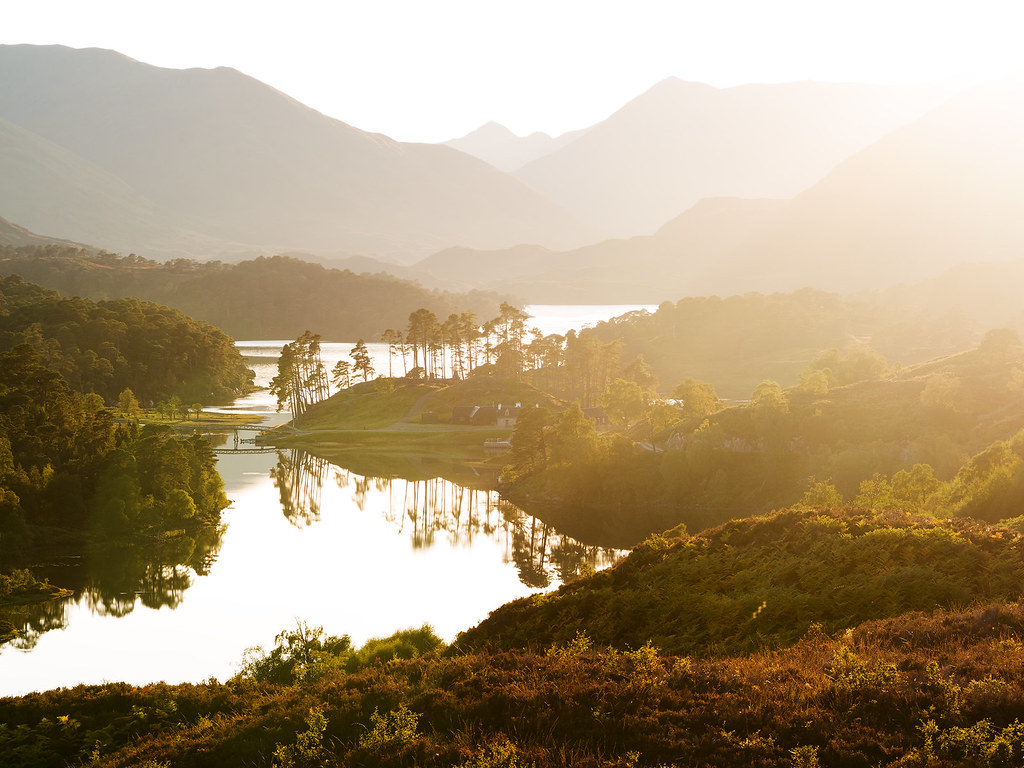


3 comments
Gaitan Martinez
Already I could tell the article was going to be great due to the beautiful imagery the author chose, props to that! Scotland is already one of the places to visit on my list, and this article makes me want to visit it sooner than expected. Very interesting article and glad to know more about the animals and their ecosystem. Also I appreciate the little Loch Ness Monster hint because that’s a part of Scottish culture.
Mariana Chamorro
Bianca, your publication on the Affric Highlands of Scotland is fantastic! You vividly describe its breathtaking landscapes.Your exploration of the Scottish wildcat and pine marten, along with the threats they face, is eye-opening and highlights the need for ongoing conservation. Great job!
Rhys Williams
I found the exploration of rewilding efforts in the Apennine Mountains fascinating and insightful. The quote highlighting the historical impact of agricultural activities in Italy underscores the intricate relationship between human interventions and environmental changes, emphasizing the importance of balancing conservation efforts with sustainable practices to preserve biodiversity and ecosystem health in the region.